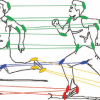Free Online Productivity Tools
i2Speak
i2Symbol
i2OCR
iTex2Img
iWeb2Print
iWeb2Shot
i2Type
iPdf2Split
iPdf2Merge
i2Bopomofo
i2Arabic
i2Style
i2Image
i2PDF
iLatex2Rtf
Sci2ools
CVPR
2009
IEEE
2009
IEEE
Layered Graph Matching by Composite Cluster Sampling with Collaborative and Competitive Interactions
This paper studies a framework for matching an unknown
number of corresponding structures in two images
(shapes), motivated by detecting objects in cluttered background
and learning parts from articulated motion. Due to
the large distortion between shapes and ambiguity caused
by symmetric or cluttered structures, many inference algorithms
often get stuck in local minimums and converge
slowly. We propose a composite cluster sampling algorithm
with a “candidacy graph” representation, where each vertex
(candidate) is a possible match for a pair of source and
target primitives (local structure or small curves), and the
layered matching is then formulated as a multiple coloring
problem. Each two vertices can be linked by either a
competitive edge or a collaborative edge. These edges indicate
the connected vertices should/shouldn’t be assigned
the same color. With this representation, the stochastic sampling
contains two steps: (i) Sampling the competitive and
collabor...
| Added | 09 May 2009 |
| Updated | 10 Dec 2009 |
| Type | Conference |
| Year | 2009 |
| Where | CVPR |
| Authors | Kun Zeng, Liang Lin, Song Chun Zhu, Xiaobai Liu |
Comments (0)

